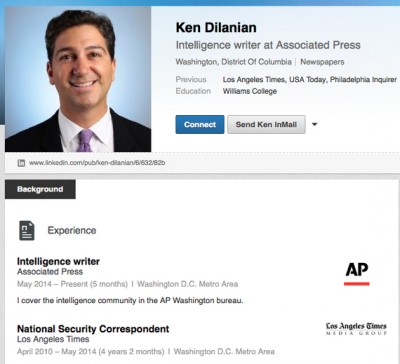CIA Emails Expose “Access Journalist” at Work – LA Times/Associated Press Reporter or Covert CIA Spokesperson?

I have mentioned before that more than 90 per cent of reporters are in some sense “access journalists” – that is, they rely on the active help of the key figures on their “beat”. Usually the people they regularly need to access are in power: crime correspondents need help from the police, much less so than criminals; diplomatic correspondents need the help of diplomats more than they need the help of drone strike victims, and so on.
It is difficult to convey quite how unhealthy this relationship – one largely of dependency – is for a profession that claims to be a “fourth estate”, a supposed counterweight to other power centres. But now, thanks to Freedom of Information requests to the CIA, we have a great illustration of how this relationship works.
Released documents show two months of emails from Ken Dilanian, then working for the Los Angeles Times, and the CIA press office (the CIA’s responses are not included). Today, Dilanian is AP’s intelligence reporter. The emails are more than chummy, and show Dilanian regularly sending the CIA drafts of his stories and seeking their blessing, even though this clearly violated the LA Times’ code of conduct (and every journalistic code of conduct, for that matter). He appears to identify strongly with the CIA and was ready to tone down his copy at their request.
According to the report in the Intercept, when members of Congress wrote to Barack Obama in 2012 saying they were “deeply concerned” about the drone programme, Dilanian emailed the agency pitching his story as “a good opportunity” for the government:
Not only would such a story be reassuring to the public, I would think, but it would also be an opportunity to explore the misinformation about strikes that sometimes comes out of local media reports. It’s one thing for you to say three killed instead of 15, and it’s another for congressional aides from both parties to back you up. Part of what the story will do, if you could help me bring it to fruition, is to quote congressional officials saying that great care is taken to avoid collateral damage and that the reports of widespread civilian casualties are simply wrong.
I particularly like this exchange:
On March 14, 2012, Dilanian sent an email to the press office with a link to a Guardian story that said Bashar Al-Assad’s wife had been buying a fondue set on Amazon while Syrian protesters were gunned down. “If this is you guys, nice work,” he wrote. “If it’s real, even better.”
And it seems Dilanian thought it was his job to outsmart the CIA public relations office in polishing up the agency’s image:
Dilanian also closely collaborated with the CIA in a May 2012 story that minimized the agency’s cooperation with director Kathryn Bigelow and screenwriter Mark Boal on their film about the assassination of Osama bin Laden, Zero Dark Thirty. Republicans had been criticizing the Obama Administration for revealing classified details about the operation to Boal and Bigelow while withholding them from the public.
“My angle on this is that…this is a pretty routine effort to cooperate with filmmakers and the sort of thing the CIA has been doing for 15 years,” Dilanian wrote in an email to Cynthia Rapp, the head of the agency’s press office. “This is a storyline that is in your interest, I would think, to the extent you could provide information about how routine it is to offer guidance to entertainment people who seek it out—including ones who are Democrats!—it would show that this latest episode is hardly a scandal.” …
One year later, internal CIA documents released under the FOIA showed that the agency’s office of public affairs—the same people Dilanian had been working with–had asked for and received changes to the Zero Dark Thirty script that portrayed the agency in a more favorable light.
Interesting too to see how his editors responded, when confronted with these basic violations of journalistic ethics:
AP spokesman Paul Colford told The Intercept that the news organization is “satisfied that any pre-publication exchanges that Ken had with the CIA before joining AP were in pursuit of accuracy in his reporting on intelligence matters,” adding that “we do not coordinate with government agencies on the phrasing of material.”
So, even though he was caught with his hand in the till, Dilanian will pay no price for failing both to do his job properly (which, you would assume, was to hold the CIA to account) and to follow his own organisations’ codes of ethics. That is doubtless because these editors understand that most other reporters are doing the same.
Chomsky and Herman have shown how corporate journalism effectively weeds out journalists who show too much independence, leading to a system in which the mainstream media comprise staff who share values with our power elites. The need by journalists for access to these power centres is one of the key components of this filtering system. If you are not prepared to be chummy with the CIA, you won’t last long as an intelligence reporter. And it is these kinds of high-profile posts that one needs to succeed in before rising up the ladder into senior editorial and executive positions. Access journalism and corporate journalism stand or fall together.

